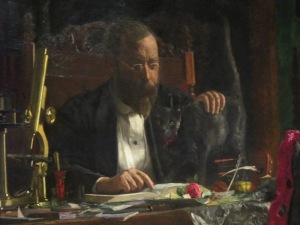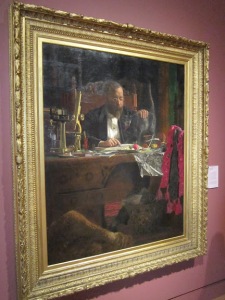
It may not have been the first choice for a major work by Thomas Eakins to adorn the walls of the Crystal Bridges Museum in Bentonville, Arkansas. That of course was The Gross Clinic which shows Dr.Samuel D. Gross, a seventy-year-old professor dressed in a black frock coat, as he lectures a group of Jefferson Medical College students.
While The Gross Clinic shows a scientific medical procedure grandly, the Portrait of Professor Benjamin H. Rand at Crystal Bridges Museum of American Art portrays the subject, not primarily for achievements and occupation, but as a person well known by and admired by the painter.
Approaching the canvas we see Dr. Rand busily at work at his desk. The portrait appears to show Rand late at night, perhaps returning to his work after an evening out. Work isn’t easy, however as it is distracted by interruptions including those from a grey cat.

The painting was completed in 1874, a year before The Gross Clinic to mark the retirement of Dr. Rand. It was purchased by Alice Walton from Crystal Bridges for an estimated $20 million from Jefferson Medical College, where it and The Gross Clinic hung.
According to The Revenge of Thomas Eakins by Sidney Kirkpatrick, Rand had provided a role model to the younger Eakins and continued, decades later, to inspire him. The inclusion of the cat suggests Rand’s love for all living creatures. The disparate elements in the painting combine to form a holistic view of Rand, and “The viewer begs to know who has sent the rose.”
There’s little need to argue that The Gross Clinic is a great painting, but while it accomplishes much, it doesn’t portray the persona of the characters nearly as well as other works by Eakins. From The Gross Clinic we learn Dr. Gross is an important man doing important things. It provides contemporary viewers with the drama of a stage and a sense of achievement, but its paintings like the Portrait of Professor Benjamin H. Rand and The Writing Master at the Met lend complete information about people from 19th Century Philadelphia to modern viewers.
Perhaps in the end it’s the sense of achievement that matters most, but for an artist, I think it’s the ability to portray the persona of the sitter that is the greatest achievement. Eakins is among few masters able to achieve this to such a degree.
Discover more from Urban Art & Antiques
Subscribe to get the latest posts sent to your email.

